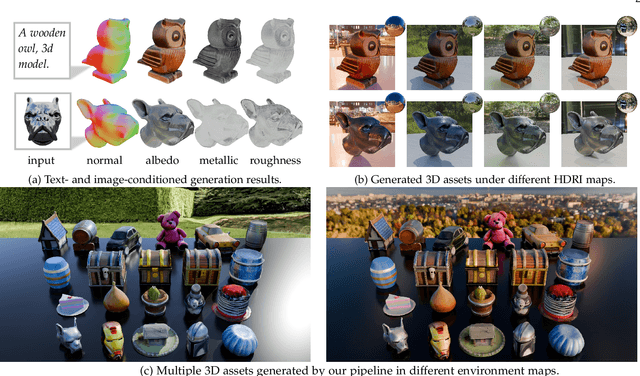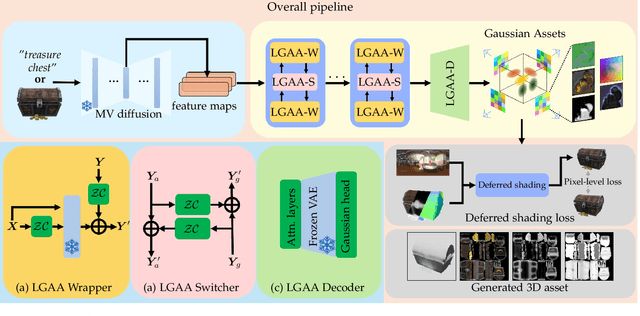Wei Sui
DreamLifting: A Plug-in Module Lifting MV Diffusion Models for 3D Asset Generation
Sep 09, 2025



Abstract:The labor- and experience-intensive creation of 3D assets with physically based rendering (PBR) materials demands an autonomous 3D asset creation pipeline. However, most existing 3D generation methods focus on geometry modeling, either baking textures into simple vertex colors or leaving texture synthesis to post-processing with image diffusion models. To achieve end-to-end PBR-ready 3D asset generation, we present Lightweight Gaussian Asset Adapter (LGAA), a novel framework that unifies the modeling of geometry and PBR materials by exploiting multi-view (MV) diffusion priors from a novel perspective. The LGAA features a modular design with three components. Specifically, the LGAA Wrapper reuses and adapts network layers from MV diffusion models, which encapsulate knowledge acquired from billions of images, enabling better convergence in a data-efficient manner. To incorporate multiple diffusion priors for geometry and PBR synthesis, the LGAA Switcher aligns multiple LGAA Wrapper layers encapsulating different knowledge. Then, a tamed variational autoencoder (VAE), termed LGAA Decoder, is designed to predict 2D Gaussian Splatting (2DGS) with PBR channels. Finally, we introduce a dedicated post-processing procedure to effectively extract high-quality, relightable mesh assets from the resulting 2DGS. Extensive quantitative and qualitative experiments demonstrate the superior performance of LGAA with both text-and image-conditioned MV diffusion models. Additionally, the modular design enables flexible incorporation of multiple diffusion priors, and the knowledge-preserving scheme leads to efficient convergence trained on merely 69k multi-view instances. Our code, pre-trained weights, and the dataset used will be publicly available via our project page: https://zx-yin.github.io/dreamlifting/.
DISCOVERSE: Efficient Robot Simulation in Complex High-Fidelity Environments
Jul 29, 2025Abstract:We present the first unified, modular, open-source 3DGS-based simulation framework for Real2Sim2Real robot learning. It features a holistic Real2Sim pipeline that synthesizes hyper-realistic geometry and appearance of complex real-world scenarios, paving the way for analyzing and bridging the Sim2Real gap. Powered by Gaussian Splatting and MuJoCo, Discoverse enables massively parallel simulation of multiple sensor modalities and accurate physics, with inclusive supports for existing 3D assets, robot models, and ROS plugins, empowering large-scale robot learning and complex robotic benchmarks. Through extensive experiments on imitation learning, Discoverse demonstrates state-of-the-art zero-shot Sim2Real transfer performance compared to existing simulators. For code and demos: https://air-discoverse.github.io/.
Efficient Task-specific Conditional Diffusion Policies: Shortcut Model Acceleration and SO(3) Optimization
Apr 14, 2025



Abstract:Imitation learning, particularly Diffusion Policies based methods, has recently gained significant traction in embodied AI as a powerful approach to action policy generation. These models efficiently generate action policies by learning to predict noise. However, conventional Diffusion Policy methods rely on iterative denoising, leading to inefficient inference and slow response times, which hinder real-time robot control. To address these limitations, we propose a Classifier-Free Shortcut Diffusion Policy (CF-SDP) that integrates classifier-free guidance with shortcut-based acceleration, enabling efficient task-specific action generation while significantly improving inference speed. Furthermore, we extend diffusion modeling to the SO(3) manifold in shortcut model, defining the forward and reverse processes in its tangent space with an isotropic Gaussian distribution. This ensures stable and accurate rotational estimation, enhancing the effectiveness of diffusion-based control. Our approach achieves nearly 5x acceleration in diffusion inference compared to DDIM-based Diffusion Policy while maintaining task performance. Evaluations both on the RoboTwin simulation platform and real-world scenarios across various tasks demonstrate the superiority of our method.
GeoFlow-SLAM: A Robust Tightly-Coupled RGBD-Inertial Fusion SLAM for Dynamic Legged Robotics
Mar 18, 2025Abstract:This paper presents GeoFlow-SLAM, a robust and effective Tightly-Coupled RGBD-inertial SLAM for legged robots operating in highly dynamic environments.By integrating geometric consistency, legged odometry constraints, and dual-stream optical flow (GeoFlow), our method addresses three critical challenges:feature matching and pose initialization failures during fast locomotion and visual feature scarcity in texture-less scenes.Specifically, in rapid motion scenarios, feature matching is notably enhanced by leveraging dual-stream optical flow, which combines prior map points and poses. Additionally, we propose a robust pose initialization method for fast locomotion and IMU error in legged robots, integrating IMU/Legged odometry, inter-frame Perspective-n-Point (PnP), and Generalized Iterative Closest Point (GICP). Furthermore, a novel optimization framework that tightly couples depth-to-map and GICP geometric constraints is first introduced to improve the robustness and accuracy in long-duration, visually texture-less environments. The proposed algorithms achieve state-of-the-art (SOTA) on collected legged robots and open-source datasets. To further promote research and development, the open-source datasets and code will be made publicly available at https://github.com/NSN-Hello/GeoFlow-SLAM
Monocular Depth Estimation and Segmentation for Transparent Object with Iterative Semantic and Geometric Fusion
Feb 20, 2025Abstract:Transparent object perception is indispensable for numerous robotic tasks. However, accurately segmenting and estimating the depth of transparent objects remain challenging due to complex optical properties. Existing methods primarily delve into only one task using extra inputs or specialized sensors, neglecting the valuable interactions among tasks and the subsequent refinement process, leading to suboptimal and blurry predictions. To address these issues, we propose a monocular framework, which is the first to excel in both segmentation and depth estimation of transparent objects, with only a single-image input. Specifically, we devise a novel semantic and geometric fusion module, effectively integrating the multi-scale information between tasks. In addition, drawing inspiration from human perception of objects, we further incorporate an iterative strategy, which progressively refines initial features for clearer results. Experiments on two challenging synthetic and real-world datasets demonstrate that our model surpasses state-of-the-art monocular, stereo, and multi-view methods by a large margin of about 38.8%-46.2% with only a single RGB input. Codes and models are publicly available at https://github.com/L-J-Yuan/MODEST.
A Light-Weight Framework for Open-Set Object Detection with Decoupled Feature Alignment in Joint Space
Dec 19, 2024



Abstract:Open-set object detection (OSOD) is highly desirable for robotic manipulation in unstructured environments. However, existing OSOD methods often fail to meet the requirements of robotic applications due to their high computational burden and complex deployment. To address this issue, this paper proposes a light-weight framework called Decoupled OSOD (DOSOD), which is a practical and highly efficient solution to support real-time OSOD tasks in robotic systems. Specifically, DOSOD builds upon the YOLO-World pipeline by integrating a vision-language model (VLM) with a detector. A Multilayer Perceptron (MLP) adaptor is developed to transform text embeddings extracted by the VLM into a joint space, within which the detector learns the region representations of class-agnostic proposals. Cross-modality features are directly aligned in the joint space, avoiding the complex feature interactions and thereby improving computational efficiency. DOSOD operates like a traditional closed-set detector during the testing phase, effectively bridging the gap between closed-set and open-set detection. Compared to the baseline YOLO-World, the proposed DOSOD significantly enhances real-time performance while maintaining comparable accuracy. The slight DOSOD-S model achieves a Fixed AP of $26.7\%$, compared to $26.2\%$ for YOLO-World-v1-S and $22.7\%$ for YOLO-World-v2-S, using similar backbones on the LVIS minival dataset. Meanwhile, the FPS of DOSOD-S is $57.1\%$ higher than YOLO-World-v1-S and $29.6\%$ higher than YOLO-World-v2-S. Meanwhile, we demonstrate that the DOSOD model facilitates the deployment of edge devices. The codes and models are publicly available at https://github.com/D-Robotics-AI-Lab/DOSOD.
CAMAv2: A Vision-Centric Approach for Static Map Element Annotation
Jul 31, 2024



Abstract:The recent development of online static map element (a.k.a. HD map) construction algorithms has raised a vast demand for data with ground truth annotations. However, available public datasets currently cannot provide high-quality training data regarding consistency and accuracy. For instance, the manual labelled (low efficiency) nuScenes still contains misalignment and inconsistency between the HD maps and images (e.g., around 8.03 pixels reprojection error on average). To this end, we present CAMAv2: a vision-centric approach for Consistent and Accurate Map Annotation. Without LiDAR inputs, our proposed framework can still generate high-quality 3D annotations of static map elements. Specifically, the annotation can achieve high reprojection accuracy across all surrounding cameras and is spatial-temporal consistent across the whole sequence. We apply our proposed framework to the popular nuScenes dataset to provide efficient and highly accurate annotations. Compared with the original nuScenes static map element, our CAMAv2 annotations achieve lower reprojection errors (e.g., 4.96 vs. 8.03 pixels). Models trained with annotations from CAMAv2 also achieve lower reprojection errors (e.g., 5.62 vs. 8.43 pixels).
VRSO: Visual-Centric Reconstruction for Static Object Annotation
Mar 22, 2024Abstract:As a part of the perception results of intelligent driving systems, static object detection (SOD) in 3D space provides crucial cues for driving environment understanding. With the rapid deployment of deep neural networks for SOD tasks, the demand for high-quality training samples soars. The traditional, also reliable, way is manual labeling over the dense LiDAR point clouds and reference images. Though most public driving datasets adopt this strategy to provide SOD ground truth (GT), it is still expensive (requires LiDAR scanners) and low-efficient (time-consuming and unscalable) in practice. This paper introduces VRSO, a visual-centric approach for static object annotation. VRSO is distinguished in low cost, high efficiency, and high quality: (1) It recovers static objects in 3D space with only camera images as input, and (2) manual labeling is barely involved since GT for SOD tasks is generated based on an automatic reconstruction and annotation pipeline. (3) Experiments on the Waymo Open Dataset show that the mean reprojection error from VRSO annotation is only 2.6 pixels, around four times lower than the Waymo labeling (10.6 pixels). Source code is available at: https://github.com/CaiYingFeng/VRSO.
Gyroscope-Assisted Motion Deblurring Network
Feb 10, 2024Abstract:Image research has shown substantial attention in deblurring networks in recent years. Yet, their practical usage in real-world deblurring, especially motion blur, remains limited due to the lack of pixel-aligned training triplets (background, blurred image, and blur heat map) and restricted information inherent in blurred images. This paper presents a simple yet efficient framework to synthetic and restore motion blur images using Inertial Measurement Unit (IMU) data. Notably, the framework includes a strategy for training triplet generation, and a Gyroscope-Aided Motion Deblurring (GAMD) network for blurred image restoration. The rationale is that through harnessing IMU data, we can determine the transformation of the camera pose during the image exposure phase, facilitating the deduction of the motion trajectory (aka. blur trajectory) for each point inside the three-dimensional space. Thus, the synthetic triplets using our strategy are inherently close to natural motion blur, strictly pixel-aligned, and mass-producible. Through comprehensive experiments, we demonstrate the advantages of the proposed framework: only two-pixel errors between our synthetic and real-world blur trajectories, a marked improvement (around 33.17%) of the state-of-the-art deblurring method MIMO on Peak Signal-to-Noise Ratio (PSNR).
A Vision-Centric Approach for Static Map Element Annotation
Sep 21, 2023



Abstract:The recent development of online static map element (a.k.a. HD Map) construction algorithms has raised a vast demand for data with ground truth annotations. However, available public datasets currently cannot provide high-quality training data regarding consistency and accuracy. To this end, we present CAMA: a vision-centric approach for Consistent and Accurate Map Annotation. Without LiDAR inputs, our proposed framework can still generate high-quality 3D annotations of static map elements. Specifically, the annotation can achieve high reprojection accuracy across all surrounding cameras and is spatial-temporal consistent across the whole sequence. We apply our proposed framework to the popular nuScenes dataset to provide efficient and highly accurate annotations. Compared with the original nuScenes static map element, models trained with annotations from CAMA achieve lower reprojection errors (e.g., 4.73 vs. 8.03 pixels).
 Add to Chrome
Add to Chrome Add to Firefox
Add to Firefox Add to Edge
Add to Edge